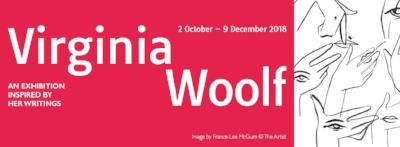Virginia Woolf Exhibition
Ellie Mitchell
Virginia Woolf: An Exhibition Inspired by her Writings
Fitzwilliam Museum, Cambridge
‘For we think back through our mothers if we are women.’
I like to picture Virginia Woolf, in ill-fitting clothes and with her glasses perched precariously on the end of her nose, saying this in her clear and solemn kind of way to the young women of Girton and Newnham in October 1928. I like to picture her looking up from the page before her, taking a pause, and pronouncing with a drag of weariness: ‘For we think back through our mothers if we are women.’
An expressive expansion on this statement, Virginia Woolf: An Exhibition Inspired by her Writings, brings together the vast and diverse creative efforts of over eighty female artists from 1854 to the present day with the aim of ‘weaving together an artistic, matriarchal genealogy’. The exhibition is divided into four parts, moving from ‘the self in public’ to ‘the self in private’ to ‘still life, the home and a room of one’s own’ to ‘landscape and place’. We see in these divisions, of course, shades of Woolf’s musings in November 1928 on ‘the inner & the outer’ worlds.
The exhibition’s first part, on ‘The Self in Public’, is made up mostly of a variety of women’s self-portraits. To be a woman who is looking at women who are looking at you as a result of having looked at themselves is a curious thing, and I lingered in this part of the room to ponder it. The phrase ‘self-assurance’ appears repeatedly in the wall labels for these self-portraits and brought me to thoughts of the steadfast resilience and independence of spirit behind each piece. These self-portraits defy the Charles Tansleys of the world, their whispers of ‘women can’t paint, women can’t write’, and reply: nobody assures me but myself, and here she is.
Wandering on (for I recommend exploring the exhibition slowly and without agenda), ‘The Self in Private’ emerges. Here, I was both delighted and discomforted (for all the truest art, and Woolf’s writing is that, both delights and discomforts) by Penny Slinger’s ‘An Exorcism’ (1977) series. This series of photographic collages cut together Slinger’s own nude form with the grandiose form of an abandoned gothic mansion: the madwoman in the attic becomes the attic in the madwoman; she no longer haunts the room, but the room haunts her.
The exhibition’s third part, on ‘Still Life, the Home and a Room of One’s Own’, is an excellent assortment of paintings, textile prints, interior views and experimental pieces. Sticking out from the softnesses of Vanessa Bell’s domestic studies and of paintings such as Ethel Sands’s ‘The Chintz Couch’ (c. 1910) or Dorothy Brett’s ‘Pond at Garsington’ (1919) are Sara Barker’s two 2016 pieces, ‘unweeding family histories’ and ‘soil knotted like toppled alphabets’. I spotted the latter of these first, and almost gasped. It is Between the Acts (1941). It is all swirls and shards, this and that, and there, in the centre, a shard of mirror: ‘ourselves’. Its colours are dirt and clouds and the piece alters with where you stand, with what the mirror reflects, with the viewer’s own placing in relation to it. Its partner piece, similarly, is To the Lighthouse (1927): both ship- and sea-shaped, with an anchor at its base and a single defining line. I am still thinking of these works weeks later.
Arriving at the exhibition’s final part on ‘Landscape and Place’ is like coming in to dock after the voyage out. Here, a serenity of scenes including Gluck’s ‘Cornwall Landscape’ (1968), Laura Knight’s ‘A Green Sea’ (1918) and Marie Yates’s ‘Field Working Paper’ (1972). This last piece is a series of nine photographs, each of a coastline installation at different tide times. The series is subtle, washes in and washes out, smudges and sharpens, and I could not help but be reminded of the nine sections of The Waves (1931). I watched this piece for a long time.
Virginia Woolf: An Exhibition Inspired by her Writings develops from Woolf’s statement that ‘we think back through our mothers if we are women’ and its achievement is that it thinks not only back through to Woolf, but also forwards and into and around and out from. Its variety is testament to the variety of response that Woolf’s writings have inspired and to the variety of that which Woolf herself was responding to when she wrote them.
Virginia Woolf: An Exhibition Inspired by her Writings was open at the Fitzwilliam Museum, Cambridge until Sunday 9 December 2018.
https://www.fitzmuseum.cam.ac.uk/virginiawoolf
*
Literature Cambridge will visit the Fitzwilliam Museum to see the manuscript of A Room of One’s Own on our summer course 2019, Virginia Woolf’s Gardens. 14-19 July 2019.



